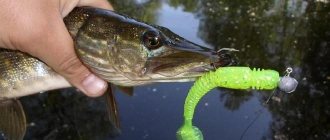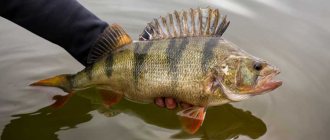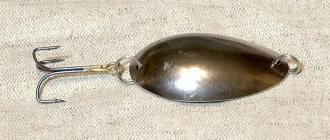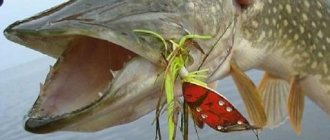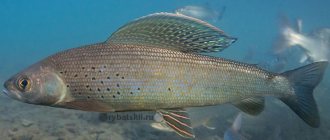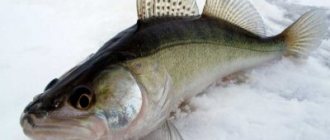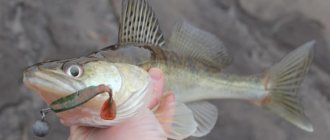What to use to catch catfish in winter
Catching catfish in winter should be done using silicone baits with a weighted head. It sinks perfectly to the bottom where the catfish live. The length of the bait should be from 10 to 17 cm. The color of the bait depends entirely on the color of the water. So, in clear water you can use silver and golden products, and in cloudy water - yellow ones. Bright lures with glitter give a good effect. More information about the above products can be found in the article “Silicone baits: species diversity, features of use.”
What to catch
Even being in a semi-anabiosis state, the catfish continues to be a strong fish and will not give up right away, so the tackle must be strong. It doesn’t matter whether it’s an expensive winter spinning rod for ice fishing or a homemade wooden fishing rod with a simple reel. The main thing is that both the fishing rod itself and the equipment can withstand fishing for catfish.
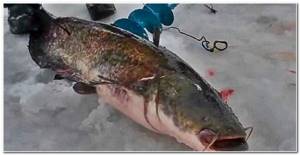
What to offer the sleepy giant? It is clear that catching it with a jig is like going after a bear with an awl. The baits used in this kind of fishing are silicone twisters and large vibrating tails, starting from 10 cm in length. The artificial fish is delivered to the bottom layer on a lead spherical head with a single hook, the weight of which depends on the speed of the current. In a fast flow you have to use weights weighing up to 100 g. It would be nice if the rubber was edible. As for the color of the bait, it is selected taking into account the state of the water: for transparent – green and brown colors, for muddy – silver and yellow.
If silicone is not a fish for catfish, perhaps it will be interested in worms - a natural bait with a natural smell. It is advisable to sprinkle a bunch of worms with an attractant to make the bait even more attractive. A reasonable question arises: where to get worms in winter? Experienced fishermen solve the problem simply: they breed them in the garage or basement. In a large wooden box you can breed such a colony that there will be enough bait until spring.
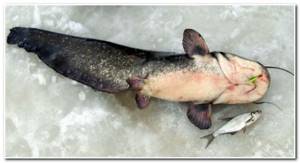
Catfish fishing method
Lead heads, where the hooks are located at an angle of 45 degrees, have proven to be excellent for catching catfish in winter. Their weight should be from 15 to 35 grams. In areas with moderate currents, heads of various shapes and weights can be used. In places where the current is strong, it is recommended to use a head whose weight is at least 20 grams, and its shape should be similar to an olive. Many fishermen say that in winter you can’t catch catfish without silicone bait.
Features of winter fishing for catfish
A characteristic sign of catfish behavior with the onset of cold weather is its movement to wintering pits. But this does not mean that freshwater giants hibernate. The feeding process slows down significantly, but does not stop. Smaller individuals can move to the edges while searching for food, since they have no chance of competing with their larger counterparts in obtaining food.
Edible objects that come into the catfish's field of vision usually do not go unnoticed. But this happens when food appears in the immediate vicinity of its site. In this case, competition for the right to capture prey is possible. All these nuances must be taken into account in the process of amateur fishing for winter catfish.
Old-fashioned way
It is better to determine where the catfish holes are in the summer. The deeper the hole, the more fish will live in it.
First, you have to cut a hole in the ice. Then throw the equipment into it with a self-propelled gun. If you cut the hole correctly, the effect will be immediate.
It is necessary to pull out the sauger carefully, as several fish may be caught on it at once. At the same time, there is no need to slow down, the catfish will slide off! To be on the safe side, pierce the catfish on the surface with a hook.
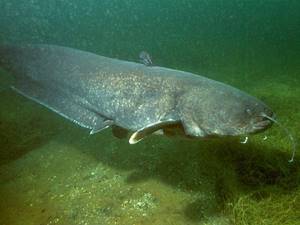
Closely related species of catfish
The common or European catfish belongs to the genus Soma, family Catfish, order Catfish. The order Catfish includes 40 families. The Catfish family includes about 11-12 genera and about 97-100 species. The genus Soma includes 14 species. The closest related species to the European catfish are the Soldatov's catfish and the Amur catfish. In addition to them, on the territory of our country there are Channel catfish and American catfish, which are also included in the order Catfish, but belong to the family of Iktalur catfish.
Som Soldatova
(Silurus soldatovi) is a large fish reaching a length of up to 3 meters and a weight of up to 80 kg. Inhabits the Amur River basin, the Ussuri River and Lake Khanka. In appearance, size and color it is similar to the common catfish. Its back and sides are gray, with brown streaks, and its belly is light. Eats fish. Hunts at night. In the fall it goes to the depths, where it spends the entire winter without feeding. Reaches sexual maturity at 4 years. Spawning of Soldatov's catfish occurs in June-July, in coastal thickets. Soldatov's catfish is considered a rare fish; its numbers are constantly declining, which is why it is listed in the Red Book of the Russian Federation.
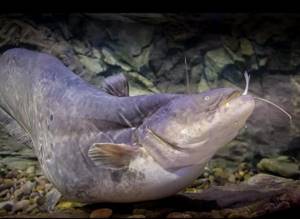
Amur catfish
(Parasilurus asotus) lives in Japan, China and Korea. In 1933, the Amur catfish was released into the rivers of Primorye, where it took root and multiplied. Found in Lake Baikal. The length of the Amur catfish is up to 1 meter, weight 6-8 kg. The body color of the Amur catfish is dark green, the belly is light. Prefers to settle in standing or bodies of water with weak currents. In summer it goes into channels, floods and the coastal zone. In autumn it goes deeper. It feeds on small fish, mollusks, frogs and crayfish. Hunt from ambush in the evening and at night. Reaches sexual maturity by 4 years. Spawning occurs from late May to July. It lays eggs on aquatic plants. The Amur catfish is widely fished; its meat is highly prized for its taste and low bone count.
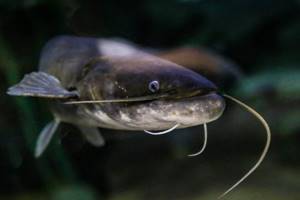
Channel catfish
(Ictalurus punctatus) is a fish of the Ictaluridae family. Lives in the USA, southern Canada, northern Mexico. The body length of channel catfish is from 60 to 130 cm, maximum weight is 4.5-9 kg. The body color is bluish-olive, gray, black, with spots on the sides, the belly is light. It feeds on fish, shellfish, insects, frogs, crayfish, and small mammals.
You might be interested in: Twitching
The most common catfish in North America, about 8 million American anglers fish for channel catfish. Since 1972, channel catfish began to be bred in Russia, in the Krasnodar Territory. From the ponds, the channel catfish entered the rivers of the Don and Kuban systems. Channel catfish are bred in ponds in the Moscow region and the Urals.
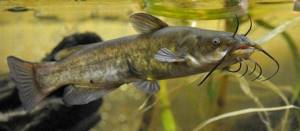
American catfish
(Ictalurus nebulosus) is a fish of the Ictaluridae family. American catfish live in overgrown, slow-moving and stagnant bodies of water with silty bottoms in North America. Introduced to Europe for breeding in ponds, spread throughout the water bodies of Belarus and Ukraine, and can be found in the western regions of Russia. The length of the American catfish reaches 1 meter. Very hardy to living conditions, can live in poor water where other fish species cannot live. Can burrow into the ground. Hunts and feeds at night. Unpretentious in food.
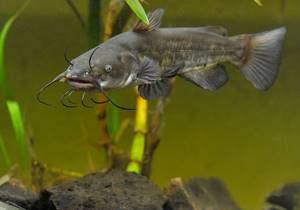
Fishing for catfish.
The catfish bite varies. At low water temperatures, the bite may seem to be caught on algae or snags. At favorable temperatures, the strike of a catfish can be very sharp, so you need to always be prepared, especially if you are holding a rod in your hands.
It is very important not to give your opponent a chance after a bite. How to hold the tackle as far as possible during the first jerk of the catfish. If the catfish immediately managed to turn around in the first seconds of the fight and go in the chosen direction, then its landing may drag on for a long time.
If you still managed to hold the first jerk and the catfish stopped, then immediately drag it up. At the surface of the water, the catfish cannot find shelter for itself and only tries to move to the side. At the bottom, the catfish immediately tries to go into snags or other shelter, and if it reaches the goal, then this is a defeat for the fisherman. Sometimes the catfish becomes head down to the bottom and beats from side to side with its tail. Tired of fighting, the catfish often lies on the bottom and it can be very difficult to move it, especially if the tackle is not very strong. In such cases, you need to pull the line as tight as possible and tap the bent rod with your hand. From constant shocks, the catfish often resumes movement. If the catfish does not resume movement, then you can throw stones into the water, or loudly knock on the boat. If you see bubbles rising from the bottom on the surface of the water, it means that the catfish is tired, but still don’t rush.
Pulling catfish onto land
Probably everyone understands that for catfish more than one meter, a landing net does not matter. Many people use a gaff, but I am against it. Maybe someone is catching on the principle of catch - let go, maybe someone is deciding to take such a step. If you pull a catfish out with a hook and then release it, then, in my opinion, this is flayering. The most effective and harmless way for catfish is to pull it out by the jaw. All you need for this is a glove or mitten, otherwise a rag wrapped around your hand may work. When the catfish is near the boat, or near the shore, don’t rush! Even if he looks exhausted, he can still do his best. You just need to slap the catfish in the face with your palm. I repeat: spank, not hit. Usually the catfish resumes resistance. If the catfish did not react to a slap on the face, it means that it has become completely exhausted and can be safely pulled out.
Technique for finding catfish in winter
Winter is great for targeted catching of large catfish. In cold water, catfish most often lie inactively on the bottom, but they can be provoked to grab with the help of an actively moving bait. There is no need to think that the catfish will not take the bait in water with a temperature below 6 degrees, but at such a time, in order to grab the prey, the prey must literally fall into its mouth. On most rivers where I fished, I managed to find catfish in the deepest areas in winter. These may be holes and furrows on reaches, areas near river ports or dam spillways. In cold weather, catfish often gather in schools, so they can experience several serious bites in a short time.
The best time for active vertical fishing from a boat is the first half of the day. In the evening and at night, there are noticeably fewer bites on actively supplied bait. It seems to me that catfish are hunting at this time and therefore less likely to react to bait supplied at the very bottom.
To successfully fish vertically, you need proper use of the rod, trust in your bait and good knowledge of the reservoir. The fishing technique is generally simple - you move on a boat, lowering the bait vertically to the bottom. When fishing with a spinning rod, time is spent casting; the bait plays while winding the cord onto the reel. For this reason, a bite can only occur at certain moments of spinning fishing. On the contrary, when fishing vertically, the bait remains above the very bottom for many hours. An experienced fisherman uses an echo sounder and an electric motor to control the movement of the boat and bait, which makes it possible to very accurately catch the bottom habitats of catfish.
When fishing vertically, the rod is an extension of the angler's hand. The most suitable are rigid fishing rods with a fast action, with a length from 180 to 210 cm. It is advisable to use thin-walled blanks - it is good if the rod does not weigh too much. At the same time, it must be strong enough to break the resistance of a struggling catfish.
Read: There is no fishing without ingenuity: useful tips to help a fisherman when he has no bite
The technique of baiting can be quite varied and depends on the current situation. There are three main varieties of it.
Uniform wiring . In this case, the bait must be kept at the very bottom; With this fishing technique, you can use both natural bait and silicone fish. This is quite difficult fishing, since you need to constantly monitor the echo sounder screen and concentrate on guiding the bait through vast water areas with significant depths at the required distance from the bottom. It is best caught with a bait hanging just 20 cm above the bottom - it goes directly over the heads of those lying on the bottom.
Jigging . This term refers to the constant rise of the bait and its fall, touching the bottom. In general, it is similar to fishing for cod and other bottom-dwelling fish. The angler constantly makes short or long pulls with the rod, which causes the bait to bounce. This technique is especially catchy during those hours when catfish are actively feeding.
Fire Ball . Recently, slow, smooth feeding of live or dead natural bait has become increasingly popular; More often, species such as crucian carp, carp, bream or eel are used. The fish is hung on a mount with a Fire Ball type lead head, which allows for a very natural presentation. The equipment consists of a spherical head with a short single hook and an additional leash with a tee. The fish is attached to a single hook (through the upper lip), and the tee is attached to its side. This type of rig is applied at the very bottom with slow movements of the rod tip.
The biggest difficulty with vertical fishing is the caution and distrust of catfish. An experienced fisherman presents his bait in such a way that the catfish does not suspect anything and actively grabs it. For this reason, it is advisable to use natural bait, which not only moves, but also emits a smell familiar to the predator. It’s very good if your bait imitates the natural behavior of small fish, and when approaching, the catfish begins to make sudden movements, as if trying to escape. An angler who constantly twitches his artificial fish with regular movements can cause the predator to suspect something is wrong and give up its grip. Prey that does not try to escape the predator may frighten it.
Read: To the pond for big fish. How to catch carp from ice?

